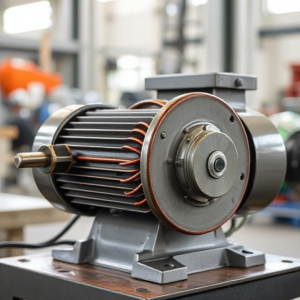An induction machine is a type of electric motor or generator that works using electromagnetic induction. They are widely used in everyday applications like fans, pumps, and industrial machinery. Induction machines are called that because they induce an electric current in the rotor (the rotating part) using a magnetic field created by the stator (the stationary part). This makes them different from other types of motors that use brushes or permanent magnets.

How Induction Motors Work (Motor Mode)
An induction motor is the most common type of electric motor. It converts electrical energy (from AC power) into mechanical energy (rotating motion). Here’s how it works:
A. Stator (The Stationary Part)
- The stator is the outer part of the motor and is connected to the electrical power supply.
- It consists of coils of wire that carry alternating current (AC), which creates a magnetic field that moves in a rotating pattern (this is the key to how the motor works).
B. Rotor (The Rotating Part)
- The rotor is the part that turns. It is located inside the stator, but it does not have direct electrical connections like the stator.
- The rotor is usually made of metal bars or coils, and it’s placed in such a way that it experiences the rotating magnetic field created by the stator.
C. Electromagnetic Induction (How Power is Transferred)
- When AC electricity flows through the stator coils, it creates a rotating magnetic field.
- This rotating field passes through the rotor. Because the rotor is inside this field, the changing magnetic field induces a current in the rotor (similar to how a generator works, but in reverse).
- Faraday’s Law of Induction explains that a changing magnetic field creates an electric current in a conductor (the rotor), which causes the rotor to start turning.
D. Rotation
- The rotor tries to follow the rotating magnetic field of the stator, but it can never quite catch up with it. This difference in speed between the stator field and the rotor is called slip.
- This slip is what creates the torque (turning force) that makes the motor spin and drive machinery.
Key Features of Induction Motors
- No Brushes: Unlike DC motors, induction motors don’t have brushes or commutators, which makes them more durable and simpler to maintain.
- Self-Starting: Induction motors don’t need any external device to start, unlike some other types of motors (like DC motors).
- Efficient: Induction motors are efficient and commonly used in many industrial applications because they are rugged and reliable.
Types of Induction Motors
There are two main types of induction motors based on the number of phases:
A. Single-Phase Induction Motor
- Used in household appliances like fans, washing machines, and small pumps.
- It uses a single-phase AC power supply (just one power line and one neutral).
- Single-phase motors are simple but less efficient than three-phase motors.
B. Three-Phase Induction Motor
- Used in industries for heavy machinery like conveyor belts, industrial pumps, and large fans.
- It uses three-phase AC power (three power lines), which provides a more powerful and smoother operation.
- Three-phase motors are more efficient and have better performance than single-phase motors.
Induction Generators (Reverse Operation)
An induction generator works the opposite way: it converts mechanical energy (motion) into electrical energy.
- When mechanical power (like from a wind turbine) drives the rotor of an induction motor, the rotor spins faster than the magnetic field of the stator.
- This creates a flow of electricity in the stator windings, which can be used as power.
- Induction generators are often used in renewable energy systems, like wind turbines.
Advantages of Induction Machines
- Simplicity: They have a simple construction with no brushes or commutators, making them easy to maintain.
- Durability: Induction motors are known for being rugged and can withstand harsh conditions.
- Cost-Effective: They are cheaper to make and maintain than other types of motors.
- Self-Starting: Unlike some motors, they start automatically when power is applied.
Disadvantages of Induction Motors
- Slip: The rotor does not turn exactly at the speed of the stator’s magnetic field, which means there is some loss of efficiency.
- Control: It can be harder to precisely control the speed of an induction motor, though modern technology allows for variable-speed control.
Summary:
- Induction machines(motors and generators) work based on electromagnetic induction.
- In motors, they convert electrical energy(from AC) into mechanical energy (rotation), and in generators, they convert mechanical energy (rotation) into electrical energy.
- They have two main parts: the stator(which creates the rotating magnetic field) and the rotor (which turns due to this field).
- Induction motors are widely used because they are simple, reliable, and cost-effective.
Tags: AC electric motor, AC motor, AC power, advantages of induction motors, alternating current motor, asynchronous motor, conveyor belts, cost-effective motor, disadvantages of induction motors, electric machinery, electric motor types, electric power conversion, electrical energy to mechanical energy, electrical machine, electricity generation, electromagnetic field, electromagnetic induction, electromagnetic torque, electromechanical energy conversion., Energy Conversion, fans, Faraday’s Law, generator applications, generator operation, household appliances, induced current, induction generator, induction machine, induction machine working principle, induction motor, industrial drives, industrial motor, maintenance-free motor, mechanical drive systems, mechanical energy to electrical energy, metal rotor bars, motor applications, motor durability, motor efficiency, motor operation, motor rotation, no brushes, no commutator, power generation, pumps, reliable motor, renewable energy systems, rotating magnetic field, rotor, rotor speed, rugged motor, self-excited generator, self-starting motor, simple motor construction, single-phase AC, single-phase induction motor, slip, slip in induction motor, speed control, squirrel cage rotor, stator, stator field speed, three-phase AC, three-phase induction motor, Torque, variable frequency drive, washing machines, wind turbine generator


